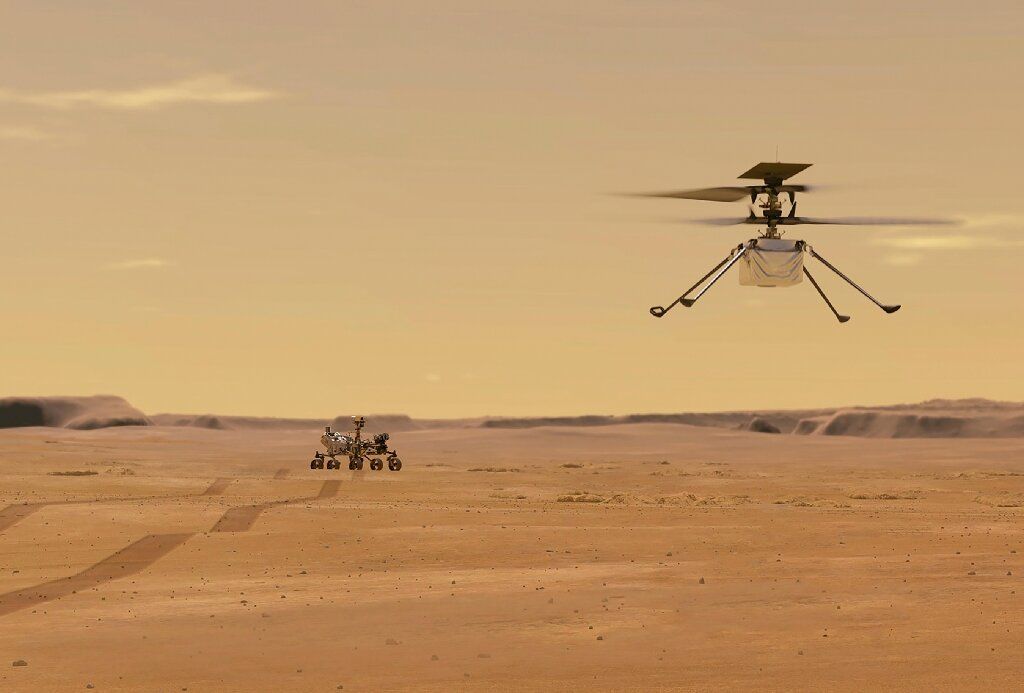The National Aeronautic Association has awarded the coveted Collier Trophy to NASA’s Jet Propulsion Lab’s Ingenuity Mars Helicopter team for “the first powered, controlled flight of an aircraft on another planet, thereby opening the skies of Mars and other worlds for future scientific discovery and exploration.” The little drone with counter-rotating rotors has logged a total of 43 minutes of flight time in 24 flights on Mars since it was deployed by the Perseverance rover in 2021. Its first flight was on April 10, 2021, and after a few test flights it began acting as a science scout for the rover, checking out promising scientific targets and finding safe routes of travel. It’s also taken plenty of high res color photos.
“Almost no one thought a helicopter could be flown on Mars,” said NAA President Greg Principato. “There were many who thought the project was not worth the effort. It is by overcoming such doubts that great achievements happen and that’s what the Ingenuity Team did. It is our honor to present them with the 2021 Collier Trophy.” Bob Balaram, who came up with the idea of putting Ingenuity on Mars, said he recently visited the Kitty Hawk site of the Wright brothers’ first flight and said he hopes there will be a similar attraction on the Red Planet. “It is my hope that, some day, when people travel to Mars’ Jezero Crater that they consider visiting where the first flight on that world occurred!”




































Good article Russ.
Ingenuity specs:
*Height: 0.49 meters (1.61ft)
*Weight (on Earth): 1.8 kilograms (3.97lbs)
*Maximum altitude: 3 to 5 meters (9.84ft-16.4ft)
*Maximum distance: 300 meters (984.2ft)
*Flight duration: 90 seconds
An antenna allows communication with a dedicated transceiver aboard Perseverance. Ingenuity stay in contact at distances of up to 300 meters.
The solar panel can fully recharge the onboard battery over one Mars day (24 hours 40 minutes).
Four carbon-fiber blades, arranged in two rotors, spin in opposite directions at 2,400 rotations per minute. Such high speeds are necessary to generate lift in the thin Martian atmosphere, which is 1 percent as dense as that of Earth.
The payload body carries Ingenuity’s guidance system, sensors, and cameras, along with a protective heater: Nighttime temperatures can drop to -90 degrees.
Lightweight construction, including carbon-fiber legs, reduces Ingenuity’s power requirements. On Mars, the helicopter weighs just 0.7 kilograms.
Six lithium-ion batteries store enough power for one 90-second flight, which draws 350 watts.
American Scientist.
Meet Vaneeza Rupani, Indian-origin Girl To Name NASA’s First Mars Helicopter
PRIYA HAZRA
July 26, 2021
Meet Vaneeza Rupani, Indian-origin girl to name NASA’s First Mars Helicopter. Rupani, who hails from Northport, Alabama, earned the honour to choose a moniker for the helicopter on the basis of her essay submitted for NASA’s “Name the Rover” contest. She picked in the honor in 2020, becoming world-famous for this.
The then 17-year-old suggestion to officially name the helicopter as Ingenuity was selected for the first aircraft to attempt powered flight on another planet.
The chopper started from Earth with NASA’s Mars 2020 rover Perseverance on July 30, beginning a nearly seven-month journey to the Red Planet.
Here’s what we know about Vaneeza Rupani:
-The young girl initially found out about the contest while reading headlines on the NASA website and decided to participate.
-Vaneeza Rupani was selected among 28,000 essays submitted by K-12 students from every US state and territory.
-In an interview published by NASA, Rupani elaborated on the reason behind choosing the name Ingenuity. She asserted that the challenges faced in designing a helicopter that is capable of flight on another planet can be overpowered only “with collaboration and creativity”. “It takes the ingenuity of an incredible group of people to create something with so many complex challenges,” she explained.
-She had an interest in space science since her Montessori years.
Read more at: shethepeople.tv/shestars/vaneeza-rupani-nasa-mars-helicopter/
A well-deserved award for a truly amazing little device.